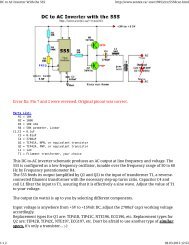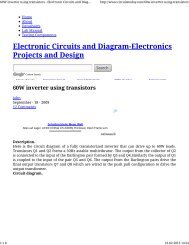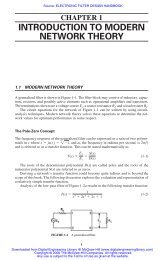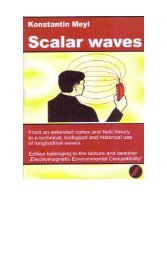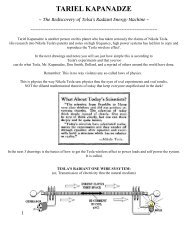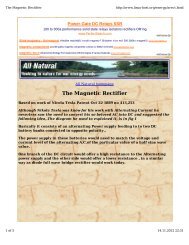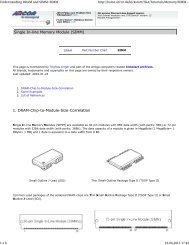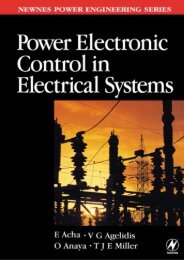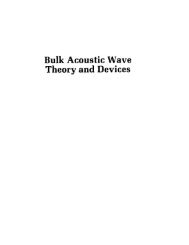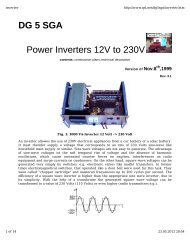New Energy Technologies Magazine nr 3 2005.pdf - Index of
New Energy Technologies Magazine nr 3 2005.pdf - Index of
New Energy Technologies Magazine nr 3 2005.pdf - Index of
Create successful ePaper yourself
Turn your PDF publications into a flip-book with our unique Google optimized e-Paper software.
It can be done in a variety <strong>of</strong> ways depending<br />
on whether this external vibration is<br />
accordant to its own tone or no. If vibrations<br />
<strong>of</strong> two bodies are acordant, the bodies are<br />
attracted; if there is a dissonance in their<br />
sound, they avoid each other. All physical<br />
forces appear due to a certain concordance<br />
(or a disagreement) <strong>of</strong> wave characteristics<br />
<strong>of</strong> vibration fields, which unite all existing<br />
matter. Vibrations play a role <strong>of</strong> an allorganizing<br />
and all-controlling source. And<br />
this source is not energy. Vibrations carry not<br />
energy but only an incentive to its absorption<br />
or production, i.e. its transformation from<br />
latent forms into evident ones. The energy is<br />
everywhere in the environment, which<br />
surrounds us and penetrates into us in an<br />
unbounded quantity. Eternal motion occurs<br />
everywhere and always. <strong>Energy</strong> reserves are<br />
unlimited in nature. We do not produce this<br />
energy and do not use it but, knowing the laws,<br />
we can transform it into useful forms. In order<br />
to do this, it is only necessary to co-ordinate<br />
operation <strong>of</strong> separate “molecular units”. It<br />
can be achieved by obtaining their<br />
consonance.<br />
Imagine that a metal support stands on a<br />
table, in front <strong>of</strong> you, and supports a hollow<br />
copper ball-sphere with a diameter <strong>of</strong> about<br />
30 cm. Numerous metal rods <strong>of</strong> different<br />
lengths and thicknesses are around the<br />
support’s base. They vibrate like tuning forks<br />
being touched by fingers. Plates and<br />
resonance tubes are placed inside the sphere.<br />
Their inter-location can be changed by<br />
handles. All this construction is called a<br />
“sympathetic transmitter”.<br />
Next to it, a cylindrical glass vessel with a<br />
diameter <strong>of</strong> 25 cm and a height <strong>of</strong> 120 cm is<br />
placed. It is filled with water. The vessel’s<br />
head, which is also metal, is connected with<br />
the sphere by thick wire from gold, silver or<br />
platinum. Three metal spheres lie on the<br />
vessel’s bottom, each <strong>of</strong> them with weight <strong>of</strong><br />
about 1 kg. As the experimenter explains,<br />
each <strong>of</strong> the spheres, as well as any other<br />
material body, has its own internal melody.<br />
The inventor comes to the sympathetic<br />
transmitter and begins to make the tuning<br />
forks vibrate, the handles turn. Suddenly, a<br />
trumpet sounds briefly and the sphere on the<br />
vessel’s bottom begins to swing, then it slowly<br />
comes <strong>of</strong>f from the bottom and goes up<br />
through water column. It hits the head,<br />
bounces <strong>of</strong>f, goes up again and, finally, settles<br />
down pressing itself to the head tightly.<br />
The trumpet sounds again, and the second<br />
metal sphere reacts to it and comes to the<br />
surface. Then the third does the same. Music<br />
subsides but the spheres still float. Actually,<br />
they still slightly come down sometimes,<br />
possibly, under the influence <strong>of</strong> accessory<br />
chords.<br />
This astonishing experiment and many others<br />
took place in John Keely’s labortory in<br />
Philadelphia more than 100 years ago. The<br />
scientist said that sound is “a violation <strong>of</strong><br />
atomic balance destroying the existing<br />
atomic particles and a substance, which is<br />
released during this process, must<br />
undoubtedly be an aether current <strong>of</strong> some<br />
order”. It is possible to say that Nature is<br />
based on vibrations <strong>of</strong> different frequencies,<br />
which create various combinations. The<br />
“accordant” harmonious combinations cause<br />
attraction and have a creative nature while<br />
disharmonious ones cause repulsion,<br />
destroy.<br />
An example <strong>of</strong> the orginized vibrations are<br />
music. When two strings <strong>of</strong> an instrument are<br />
attuned in a harmonic combination (for<br />
example, according to a third, fifth or<br />
octave), motion <strong>of</strong> one <strong>of</strong> them causes a<br />
respond in another. Since ancient times,<br />
another music was known, Kepler’s “music <strong>of</strong><br />
the spheres” created by the Sun, the Moon<br />
and planets. Today we can listen to this music<br />
in a computer arrangement.<br />
Keely brought his Sympathetic Vibratory<br />
Physics to fourty laws, in which, particularly,<br />
the unity <strong>of</strong> force and matter and also<br />
fundamental infinity <strong>of</strong> matter’s divisibility<br />
are postulated. Keely considers force as a<br />
released matter and matter as a constrained<br />
force. This was brilliantly confirmed in the<br />
XX century in the form <strong>of</strong> famous formula<br />
E=mc 2 . An idea <strong>of</strong> neutral center is<br />
considered by Keely as one <strong>of</strong> the most<br />
important physical and metaphysical<br />
42 <strong>New</strong> <strong>Energy</strong> <strong>Technologies</strong> #3(22) 2005



